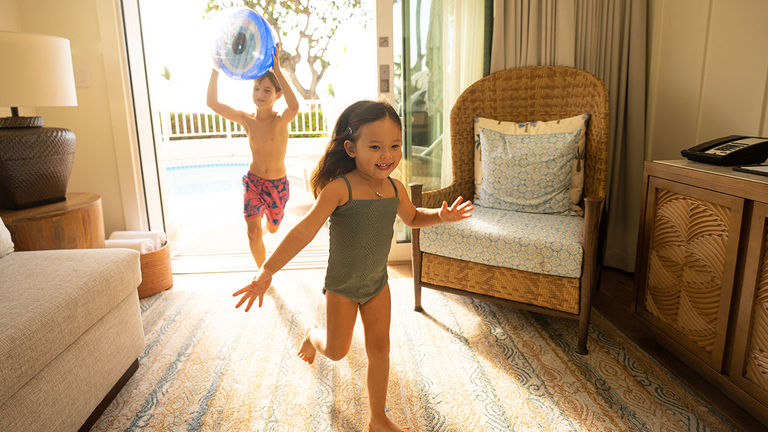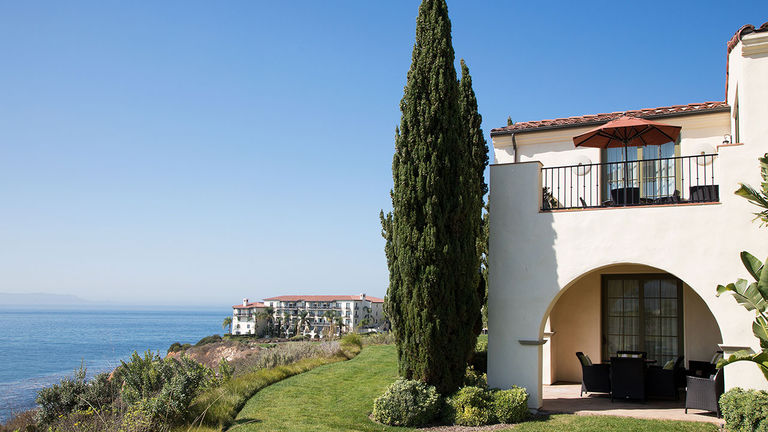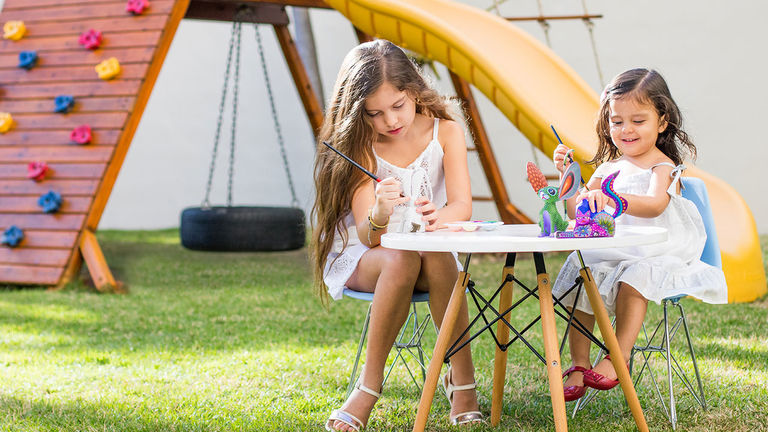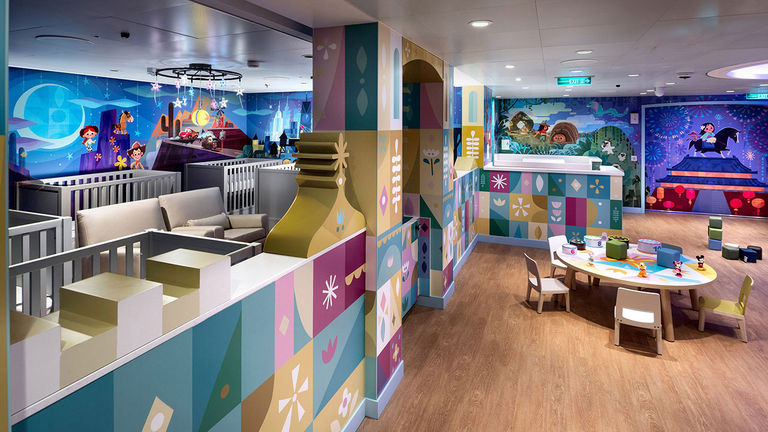“What’s the best way to travel with a toddler?” is the setup to an oft-told joke that ends with the one-word punchline: “Don’t.”
But fortunately, those who properly prep for toddler travel will discover it’s much more than “mom-ing or dad-ing with a view.”
“On vacation, I am still a parent, but there are some luxuries that I personally do not get at my house in Idaho,” said Jess Darrington, the content creator behind Where Is Briggs, a blog and social media account that details how she has navigated more than 111 flights with her 2-year-old. “When I am at home with my son, I am also cooking, cleaning and doing laundry. But on vacation, I can just enjoy being a parent.”
Travel allows parents to be more present, letting memories of a growing child’s development — and all the funny and cute things they do — crystalize.
Sign Up for Our Monthly Family Getaways Newsletter
I accept the T&C and Privacy Policy.
When I am at home with my son, I am also cooking, cleaning and doing laundry. But on vacation, I can just enjoy being a parent.
Of course, it’s not all unicorns and rainbows, and planning a trip for someone else’s toddler can be rife with challenges. Luckily, advisors can follow several best practices when working with these tiny clients, from picking the right room type and securing access to snacks to inquiring about temperament, nap time and more.
How to Plan for Traveling With Toddlers
For some clients, age is nothing but a number. But advisors should note that three years in the life of a tot are nothing short of transformative. A 1-year-old and a 3-year-old are both considered toddlers by the Centers for Disease Control and Prevention, but anyone who has been around small kids knows that an immobile, nonverbal 13-month-old will have few interests and capabilities in common with a chatty, galloping 35-month-old.
Even small things — such as liking sand — can change with age. Darrington notes that her son was not a fan of its texture on their first beach trip, but now, at age 2, he is a sandcastle connoisseur.
Beyond age, the intake portion of trip planning should include a kid’s wake, nap and bedtimes, as well as questions about temperament and tolerance.
Since everyone is different, it’s honestly too low touch to have a standard question on an intake form.
Jessica Griscavage, the founder of Runway Travel, an affiliate of Departure Lounge and a Travel + Leisure Top Travel Advisor for family travel, says she also inquires about any allergies and special needs at the start of the planning process.
There is not a one-size-fits-all approach to young kids, especially those with special needs, says Dina Farmer, founder and certified autism travel advisor of Lily and Magnolia Travel and a mother to two sons with autism.
 Dina Farmer is a mother and a certified autism travel advisor.
Dina Farmer is a mother and a certified autism travel advisor.
Credit: 2023 Dina Farmer“When you’ve met one person with autism, you’ve met one person with autism,” Farmer said. “A real conversation [with the clients] needs to be had. Since everyone is different, it’s honestly too low touch to have a standard question on an intake form.”
The Best Rooms for Families With Toddlers
Spa treatments, Michelin-starred meals and a private jet: Most parents would trade them all for guaranteed sleep during their vacation.
In the case of most families, this means avoiding an entry-level guestroom. While some make it work in one room if they bedshare or use a portable privacy device such as a SlumberPod — which envelops the child in a blackout tent — few would consider this to be ideal.
According to Darrington of Where Is Briggs, if budget allows, advisors should prevent clients from being “nap trapped” by suggesting room layouts that allow parents to relax after their kid goes down for his nap or for the night (sometimes as early as 6:30 p.m.).
 The best resorts for toddlers will offer plenty of space in guestrooms and suites, and will prevent parents from getting “nap trapped.”
The best resorts for toddlers will offer plenty of space in guestrooms and suites, and will prevent parents from getting “nap trapped.”
Credit: 2023 Fairmont Kea LaniAt the all-suite Fairmont Kea Lani on Maui, for example, rooms begin at 860 square feet and feature pocket doors separating the living room from the primary bedroom. Plus, there’s access to the lanai from both the living room and the bedroom, and the bathroom can be accessed from both rooms.
A balcony is a must on a tropical trip, Darrington says, because it allows parents to still feel like they’re on vacation even after their toddler is down for the night. She also looks for hotels with elevator access near the staircase for strollers. And for kids with autism, requesting a room in a quieter area of the hotel, and near an elevator, can be especially beneficial, says Farmer.
Finally, matching clients to the right room or hotel requires knowledge about how well their toddler tolerates a shower versus a bath. For many kids, tubs are a must.
How to Ward Off Hanger
Another non-negotiable for many parents is quick access to food. To prevent toddler tantrums and a big outing before her morning coffee, Darrington prefers to book hotels that offer included breakfast, or at least on-site options.
And advisor Griscavage aims to give her clients easy access to snacks, which are no problem to store if families have a kitchenette. Villas, condo properties or hotels that offer casitas or multi-bedroom suites are often great in this regard, such as the two- and three-bedroom Ocean View and Ocean Side casitas at Terranea resort in Southern California, and the two-bedroom Family Suite at Grand Velas Riviera Nayarit. Both offer kitchenettes, a dining table and a high chair.
 Terranea is one of the best places to travel with toddlers in Los Angeles thanks to multi-bedroom casitas that offer a kitchenette and a dining table.
Terranea is one of the best places to travel with toddlers in Los Angeles thanks to multi-bedroom casitas that offer a kitchenette and a dining table.
Credit: 2023 TerraneaAnother way to secure accessibility to milk and treats is via all-day lounge access, an add-on option at many properties by brands such as The Ritz-Carlton and Hyatt Regency.
What to Pack for a Toddler on Vacation
Parents readying for a trip often get stressed when it comes to packing. Choosing properties that provide big basics such as pack and plays, cribs and high chairs is a huge help. And some accommodations also offer childproofing gear, Griscavage says.
Bed guardrails, non-slip mats for the tub and child locks for patio or balcony doors are all things that her clients value. And because toddlers have a knack for finding danger in any space if they are not otherwise occupied, it can be helpful to bring some new toys along.
 Darrington of Where Is Briggs appreciates companies that will rent out bulky toddler gear, such as high chairs, pack and plays and even bins of toys.
Darrington of Where Is Briggs appreciates companies that will rent out bulky toddler gear, such as high chairs, pack and plays and even bins of toys.
Credit: 2023 Where Is BriggsDarrington recommends companies such as rents4baby and BabyQuip, which will meet families at the airport or at their accommodation with rental gear and even bins of toys. And Griscavage likes properties that provide special amenities for kids, such as stuffed animals, children’s books, mini robes and slippers.
“Toys that have themes in the destination where our clients are traveling go a long way, especially when they can be customized with the child’s name,” she said.
Honor Thy Client’s Nap
Between 14 and 18 months, most toddlers will drop down to one nap per day, typically in the afternoon and lasting a duration of one-and-a-half to two-and-a-half hours. When planning for the day, it’s best to respect the all-important routine and schedule a break that coincides with the daily siesta.
“I always advise my clients to know the pace and activity level that their child can handle and base a vacation and destination around that,” Griscavage said.
I always advise my clients to know the pace and activity level that their child can handle and base a vacation and destination around that.
Darrington says that advisors should ask clients if their tots are good at sleeping on the go. If not, they should avoid scheduling flights during the afternoon to avoid a meltdown.
“Clients don’t have to completely structure their trip around the sleep schedule, but having an overtired toddler is a recipe for disaster,” she said, adding that flexible reservations are especially important if the vacation involves a time change. And because of naps, she prefers to plan activities in the morning or evening.
Don’t Be Fooled by “Kids’ Clubs”
Sadly, most hotel kids’ clubs are limited to potty-trained kids, ages 4 and up. So, instead of thinking a family is set if the hotel has a kids’ club, double check the age requirements; sometimes toddlers can join, but they typically must be accompanied by a caregiver.
 Kids’ clubs might allow toddlers if they are accompanied by a caregiver.
Kids’ clubs might allow toddlers if they are accompanied by a caregiver.
Credit: 2023 Grand Velas Riviera NayaritDarrington says that Disney Cruise Line stands out in this regard, offering the “It’s a Small World” nursery program for kids 6 months old to 3 years old.
But since included childcare for toddlers is rare, advisors will want to look out for the contact information of babysitting services. Many properties will recommend a vetted company that they work with regularly.
Some parents will jump at this option, but others — especially first-timers — might be apprehensive about employing these services.
 Disney Cruise Line offers a nursery program for toddlers.
Disney Cruise Line offers a nursery program for toddlers.
Credit: 2023 Kent Phillips/DisneyDarrington, for example, admits that despite how much her family has traveled, she has hardly used these options in the past. But with a second baby on the way, she says that things might change, and that she is considering inviting grandma along more often.
The Best Places to Travel With Toddlers
According to advisor Griscavage, the best options for toddlers are places where the resort is the destination, and you can stay on-site to play and take advantage of all the amenities the hotel offers.
Theme parks and water parks are not a slam dunk for this age group, she says. She vets children’s tolerance for character meetings and busy places and tells parents to research the height limit for rides. And Farmer highly recommends going with resorts and theme parks that have some sort of autism certification or designation.
Activities that are better tolerated by most toddlers tend to be simpler. In addition to splash pads and the beach, toddlers tend to love animal encounters, such as farm visits and aquariums, and visiting natural locations where they can roam, such as parks, eateries with outdoor access and more.
Like toddlers everywhere, Farmer’s sons have most loved their beach vacations.
“If they can splash around in the ocean, explore a sandbar, eat dinner on the beach and go ghost crab hunting at night, they are overjoyed,” Farmer said. “It sounds so simple, but they get sensory needs from the crashing waves, exploring their world and being out in nature.”